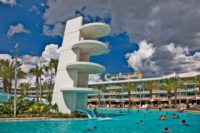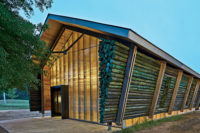Hiller'd, Denmark
While satisfying the stringent requirements for a protected monument in Denmark, SeARCH architects has unabashedly reshaped a historic farm 25 miles north of Copenhagen. The Amsterdam-based firm has converted the estate'called Favrholm, or 'beautiful island''into a corporate conference center for global health-care company Novo Nordisk, balancing an extreme intervention with restoration work on the original building. The design asserts the property's new identity, bridging the past and the future'an important gesture for an 89-year-old company dedicated to research and innovation.
The site's history is long and varied, dating back to 1364 when it was pledged to Danish king Valdemar Atterdag. For centuries, the property on the outskirts of the small city of Hillerød belonged to the throne (and was lent to vassals for farming and then used for hunting) before becoming a stud farm and, later, a research farm in 1917. The whitewashed brick building with a thatched roof that stands today was built in 1806 and declared a national landmark in 1964. In the 1980s and '90s it housed refugees. And in 1993, it was purchased by Novo Nordisk to expand its Hillerød campus, which includes a production facility and offices across Favrholm Lake. Novo Nordisk, the world's largest insulin producer and a company with a rich history itself, appreciated the significance of the agricultural connection because of its own beginnings rooted in the use of porcine and bovine pancreases for synthesizing its principal pharmaceutical product.
SeARCH was one of four firms to participate in an invited competition to transform the estate into a training complex that would engage both the mind and body and foster reflection as well as networking. The brief called for a conference center with meeting, dining, and fitness spaces, as well as guest quarters. The goal, says Isabelle Petersen, manager of the Favrholm Campus, 'was to create something exceptional''a dynamic and interactive facility for employees and guests. 'They wanted it all'all kinds of styles, a mix of this and that,' recalls SeARCH principal Bjarne Mastenbroek of his client. 'They also wished to recreate the historic, formal rectangular layout of the old farm. There were many limitations and ambitions.'
The team, closely overseen by the Heritage Agency of Denmark (KUAS), gutted the existing west wing and fitted it out for guest rooms and a fitness center. Then they renovated the central building to accommodate a lobby, dining hall, and administration, and converted former haylofts above into lounges and meeting rooms. According to preservation requirements, virtually nothing on the exterior could be altered. The rules also guided interior work, preventing changes that were not historically accurate, like leaving brickwork untreated or opening up the ceiling above the dining area. 'Our aim was to maintain the atmosphere of a farmhouse'to keep it rough'to demonstrate that the building had another function before,' says project architect Kathrin Hanf. So the team kept as much original structure as possible and used thin chalk stucco (instead of an opaque version) to emphasize the old masonry's texture.
While KUAS closely guarded existing components, the architects were free from the shackles of historicism with regard to their additions. They did not want to build one overpowering extension. Instead, they split different functions between two new volumes: a wood-clad east wing, which restores the courtyard's original form and houses an auditorium and kitchen; and a north wing for meeting rooms (Phase II will include more guest rooms at the court's south end). For the east wing, they mirrored the west wing's curve to create symmetry, and then riffed with the roofline, starting with a gable profile and morphing it into a different shape. Referencing barns that once occupied the site, the architects employed wood slats, though they applied them vertically, as a rainscreen that extends up the roofline. While respecting the old farmhouse's scale, geometry, and organization, the extension's modern lines and material treatment emphasize a friendly tension between new and old.
In sync with SeARCH's philosophy of strengthening rather than dominating the landscape, the team nestled the 18,000-square-foot steel-and-concrete north addition in the hillside, abutting the existing structure. By doing so, they preserved views of the historic building from across the lake, while maintaining the old farmhouse's dignity and standing as the complex's focal point. Extensive glazing renders the new wing as a kind of viewing platform for looking out to the water and the teeming bird life there. To counter ornithological and environmental associations' concerns, the architects limited lakeside activity, minimizing operable windows and providing no entry points on the north facade.
Novo Nordisk requested meeting rooms in a potpourri of styles'from classic to minimalist'but the architects resisted. Such an approach would have been easy to do, says Mastenbroek, but 'it doesn't work'it's too banal.' To redirect the client's wish, the architects instead proposed a 'family' of volumes. The final design takes visitors down stairs from the original central building to a cluster of meeting rooms, lounges, and patios at grade with the lake. The architects related the meeting spaces to one another by designing all of them in the shape of a leaf (or 'cow-ear'), while varying them in size, relationship to the landscape, and material palette. The scheme creates the diversity and 'style with humor' that Novo Nordisk wanted, while maintaining a distinct though cohesive aesthetic. The spaces, with their furniture-showroom-gone-wild decor, are a bit bombastic, but do impart a pleasant frisson. Still, says Mastenbroek, the focus was on opening to the landscape, not playing with forms: 'We worked a lot on reshaping the levels of the complex. You are always able to orient yourself'you always know where you are relative to the old building.'
On a recent brisk December morning, Favrholm hummed with activity, and guests used the building as if on cue: holding breakout sessions in small meeting spaces and intent conversations in hayloft lounges. The center is a poster child for an idealistic new brand of corporate labor that is proliferating in privileged enclaves, and is a welcome antidote to soul-killing hotel-conference culture. In line with the values of the company it serves, the building reflects both a deference to the past and a sense of optimism for the future.
Owner: Novo Nordisk A/S
Location: Hillerød, Denmark
Completion Date: May 2011
Gross square footage:
Building area: 7.000 m2
Conference: 1.670 m2
Auditorium: 700 m2
Hotel: 2.050 m2
Restaurant: 1.080 m2
Fitnesscentre: 500 m2
Exterior space: 50.000 m2
Cost: withheld
PeopleOwner: Novo Nordisk A/S
Architect:
Personnel in architect's firm who should receive special credit: Interior designer: Tegnestuen Vibeke Brinck aps; SeARCH
Engineer(s): Moe & Brødsgaard Acoustical: Gade Mortensen General contractor: Pihl a/s, Copenhagen DK
Photographer(s):
Renderer(s):
CAD system, project management, or other software used: |
Products
Structural system Manufacturer of any structural components unique to this project: Moelven (supplier), Finnforest (manufacturer), Lenotec (product, massive structural wood system)
Exterior cladding Metal Panels: Alucobond by 3A Composites Wood: see Eastwing cladding (above) Façade Northwing: Sto Stucco type Milano
Roofing
Windows
Metal frame: Steel: Jansen
Glazing Skylights: Scan Glass
Doors Metal doors: Eiler Thomson (supplier), Schüco (Manufacturer) Wood doors:Deco Folding doors: Dorma Hüppe
Interior finishes Suspension grid: Rockfon Demountable partitions: Rockfon Cabinetwork and custom woodwork: Moelven Wall coverings: aluminium sheets, pebblestones, paint, photo print wallpaper, acoustic stucco Paneling: Dinesen Special surfacing: photo print in resin floor Ceramic tiles in all bathrooms: Royal Mosa (NL) Resilient flooring: Nora rubber floors Wood Floors: Dinesen (tapered floor boards)
Special interior finishes unique to this project:
Furnishings
Lighting Downlights: Bega, Zumtobel, Philips, Fugato, Smartform |




































